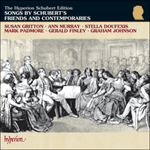The Berlin critic Ludwig Rellstab published a compilation of reviews and newspaper articles about Liszt in 1842 as a result of the concerts that made Liszt a phenomenon comparable to today’s biggest rock stars. In Rellstab’s words, Liszt would leave Berlin ‘not like a king, but as a king’. Three years later, Liszt set a poem by Rellstab,
Es rauschen die Winde, that Schubert had earlier set to music under the title ‘Herbst’ (Autumn), D945, its theme the perennial comparison of autumn to old age and the approach of death. In Liszt’s first version, the persona is agitated and desperate, with certain figures that recall Schubert’s persona in ‘Der stürmische Morgen’ from
Winterreise. The memory of springtime in parallel major mode (another song-within-a-song) also seems Schubertian in origin, proof that major mode can be as tragic as minor mode in the hands of great composers.
from notes by Susan Youens © 2010
Le critique berlinois Ludwig Rellstab a publié une compilation de critiques et d’articles de journaux sur Liszt en 1842 après les concerts qui ont fait de Liszt un phénomène comparable aux plus grandes rock stars de notre époque. Selon Rellstab, Liszt allait quitter Berlin «en roi et non comme un roi». Trois ans plus tard, Liszt a mis en musique un poème de Rellstab,
Es rauschen die Winde, sur lequel Schubert avait déjà composé un lied intitulé «Herbst» («Automne»), D945, sur le thème de l’éternel rapprochement entre l’automne, la vieillesse et l’approche de la mort. Dans la première version de Liszt, le personnage est agité et désespéré, avec certaines figures qui rappellent le personnage de Schubert dans «Der stürmische Morgen» du
Winterreise. Le souvenir du printemps en mode majeur parallèle (un autre lied dans le lied) semble également avoir une origine schubertienne, preuve que le mode majeur peut être aussi tragique que le mode mineur entre les mains des grands compositeurs.
extrait des notes rédigées par Susan Youens © 2010
Français: Marie-Stella Pâris
1842 veröffentlichte der Berliner Musikkritiker Ludwig Rellstab eine Sammlung von Rezensionen und Zeitungsartikeln über Liszt und seine Konzerte, die aus ihm eine nach heutigen Maßstäben mit den größten Rockstars vergleichbare Berühmtheit machten. Rellstab zufolge verließ Liszt Berlin „nicht wie ein König, sondern als König“. Drei Jahre später vertonte Liszt Rellstabs Gedicht
Es rauschen die Winde, das bereits von Schubert unter dem Titel „Herbst“ (D945) vertont worden war und den üblichen Vergleich zwischen Herbst, Alter und nahendem Tod bemüht. In Liszts erster Version ist die Person erregt und verzweifelt mit ähnlichen Ausdrucksmitteln wie in Schuberts „Der stürmische Morgen“ aus der
Winterreise. Die Erinnerung an den Frühling in der parallelen Dur-Tonart (ein weiteres Lied im Lied) klingt ebenfalls an Schubert an, was beweist, dass große Komponisten auch Dur so tragisch wie Moll klingen lassen können.
aus dem Begleittext von Susan Youens © 2010
Deutsch: Henning Weber


 Schubert: The Complete Songs
Schubert: The Complete Songs Songs by Schubert's friends and contemporaries
Songs by Schubert's friends and contemporaries
